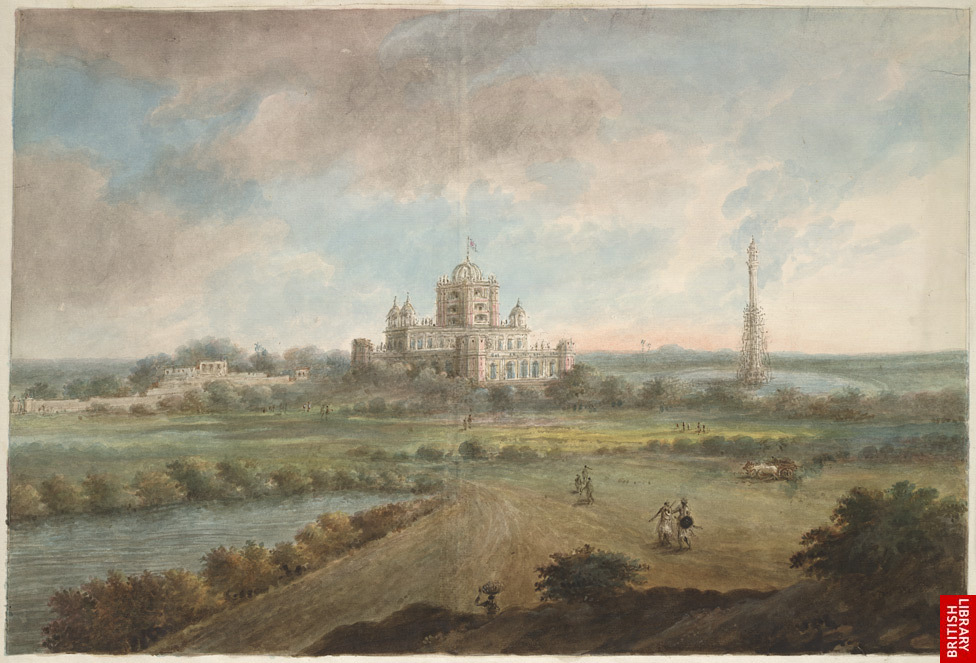Lucknow's 'Taj Mahal'!

This is because the lovely little tomb is a song sung in stone by yet another lover for the beloved. The lover was Major General Claude Martin from the 18th century who landed penniless from France to Pondicherry one day in 1752, to become one of the most intriguing citizens of Lucknow. And from the many women Martin loved, Boulone Lise was his favourite.
Martin said that his property should be particularly given to the girl name Boulone or Lise for whom he had the greatest regard and affection. She is worthy of gratitude and services rendered to him, he said writing more about his regard and satisfaction with her.
Out of deference for the customs of Lucknow society, and mindful of the prevalent purdah system, he also desired that when Boulone Lise and his other mistresses visit his tomb then every man must be drawn away from the house. Martin felt that luck had made Boulone Lise fall to his lot.
Boulone Lise was the daughter of Nawab Fazal Khan Bahadur, grandson of the Vizier to Emperor Aurangzeb. She was born in 1766 and joined Martin's household when she was about nine years old. She was nicknamed Gori Bibi or the fair mistress.
Martin mentions her lovingly and with great respect in his Will leaving instructions for her care and well being after his death and for a tomb to be constructed for her, near him. In fact Martin made generous provisions for each of the seven women in his life, two of them sisters and especially for his most amiable girl Boulone. All these women outlived Martin who died in 1800.
On his arrival, Martin was quick to note that the fortunes of the French were dwindling in India. Although he was still a teenager, he soon found employment in the English East India Company and from a common soldier rose to command the forces of the ruler of the Awadh region in Lucknow. He was made head of the local arsenal and ended up as a businessman, property owner, indigo manufacturer, moneylender, self taught architect and eventually a philanthropist.
He owned many homes, and property in Lucknow. For his resting place, Martin built the very eclectic Constantia, perhaps the largest European funerary in India. He adopted the motto labore et constantia or toil and fidelity. He willed that after his death Constantia be used as a college for instructing men in the English language, and that his tomb be well kept.
Constantia continues to intrigue citizens and visitors to the city alike.
In the 19th century WH Russell, war correspondent, The Times wrote that Constantia was the most curious structure he ever saw.
At first glance one exclaims, how beautiful! What a splendid building! At second glance the response is that it must have been built by a madman with its eccentric array of statues, the huge lions' heads, the incongruous columns, arches, pillars, windows and flights of stairs leading to nothing, which are the distinguishing features of the Constantia now La Maritinere College, felt Russell.
In comparison Boulone Lise's simple, square tomb in one corner of the sprawling premises lay hidden behind a forest of vegetation till recently.
“The tomb of Boulone Lise was forgotten by time and a society with a different code of morality,” said Carlyle McFarland, principle La Martiniere College at the release of a photo album of the now renovated tomb, by French ambassador to India Alexandre Ziegler.
McFarland does not see Boulone as a child bride but as a victim of domestic violence rescued by a benefactor who grew up pledging to him eternal gratitude and love. She was a widow longer than she was a bride. She was the mother of a son who was adopted for her and she was the matriarch who controlled the affairs of Martin's household from the confines of the zenana, or ladies quarters after he passed away.
The renovation of the tomb has been a labour of love befitting the beloved who rests there. After the forest around the mausoleum of Boulone Lise was cleared, it was discovered that the wooden rafters supporting the terrace above the plinth were made hollow by termites and dampness. The finials needed to be fired with copper to provide the distinctive green colour and had to be re constructed on a potter's wheel and placed in a kiln to replicate the original process.
The delicate and intricate lattice work was painstakingly handmade rather than machine moulded and dampness the cause for perennial exasperation of old buildings near the river was controlled by using modern methods.
Now a beautiful garden only enhancess the elegance of the stand alone structure that is seen here as a symbol of true love at a time when hate politics is trying to disturb life not only in Lucknow but in different parts of the state of Uttar Pradesh that goes to the polls early next year.



